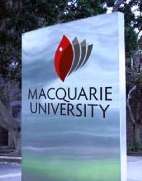Macquarie University Faculty of Science
|
| |
| Type | Public |
|---|---|
| Established | 2009 - Amalgamation of various departments |
| Students | 4,153[1] |
| Location | Sydney, New South Wales, Australia |
| Campus | Urban |
| Affiliations | Macquarie University |
| Website | science.mq.edu.au |
 | |
The Faculty of Science is a constituent body of Macquarie University. The Faculty offers undergraduate and postgraduate coursework and research degree programs and is home to a number of internationally recognised research centres and also distinguished research staff. The Science Faculty is based on the Eastern half of the Academic Core at Macquarie University and is located near to the Macquarie University Research Park and the Macquarie University Hospital, thus allowing practical links with industry and research. The Faculty is renowned for its research in such areas as chiropractic science, proteomic analysis,[2] climate risk research, environmental science and ecological studies.[3] According to The Good Universities Guide of Australian Universities, graduates within the Faculty of Science receive starting salaries higher than those who graduate in science disciplines at other Australian universities.[4]
Undergraduate Study
The Faculty offers bachelor degrees and undergraduate diplomas as part of their undergraduate programs. The Bachelor of Science offered by the faculty is a flexible program that students can tailor to suit their needs; with 25 majors available for study.[5] The Bachelor of Science degree also allows for the following options of study:
- Advanced Degrees – Involves the study of advanced topics in some majors within the Faculty as part of the Bachelor of Advanced Science.
- Double Degrees – Allows for Study of one major in the Faculty of Science and another major from other Macquarie University Faculties.
- Double Majors or Major/minor – Allows for two majors or one major and minor to be studied as part of the Bachelor of Science.
Many units within the Faculty also allow students to participate in industry visits, work experience and fieldwork studies as part of their course.
The faculty also offers structured degree options for specific areas of study where content is studied based on requirements of professional associations. These degrees are designed to prepare students for future employment in their profession. These degrees include:
- Bachelor of Biodiversity and Conservation
- Bachelor of Chiropractic Science
- Bachelor of e-Business
- Bachelor of Engineering
- Bachelor of Environment
- Bachelor of Health
- Bachelor of Information Technology
- Bachelor of Information Technology – Games Design and Development
- Bachelor of Marine Science
- Bachelor of Medical Sciences
- Bachelor of Planning
Postgraduate Study
The Faculty offers postgraduate awards in the form of master's degrees, as coursework and research degrees, doctoral studies and postgraduate diplomas or certificates. Research degrees offered to students are designed to assist students to investigate and contribute to knowledge in their chosen discipline and to develop proficiency in conducting research.[6] Specialisations within the master's coursework degrees, some which are also available as postgraduate diplomas or certificates, from the Faculty include:
- Applied Statistics
- Biodiversity and Conservation
- Biostatistics
- Biotechnology
- Chiropractic Science
- Environmental Science
- Geoscience
- Human Geography
- Information Technology
- Laboratory Quality Analysis and Management
- Marine Science and Management
- Museum Studies
- Radiopharmaceutical Science
- Sustainable Development
- Wildlife Management
Faculty Departments and Centres
The Faculty of Science is divided into separate Departments which focus on specific fields of science for research and education purposes. The Excellence in Research for Australia initiative, as part of the Australian Research Council, has recognised several departments in the Faculty for "outstanding performance well above world standard" in the fields of Earth Sciences, Physical Sciences, Environmental Sciences, Biological Sciences, and Psychology and Cognitive Sciences.[7] Centres, also referred as Research Centres, under the Faculty of Science are at the forefront of research in the university and focus on significant and emerging fields in science.
The Faculty encompasses ten departments and twenty-one centres:[8]
Departments
- Department of Biological Sciences
- Department of Chemistry and Biomolecular Sciences
- Department of Chiropractic
- Department of Computing
- Department of Earth and Planetary Sciences
- Department of Engineering
- Department of Environment and Geography
- Department of Mathematics
- Department of Physics and Astronomy
- Department of Statistics
Centres
- ARC Centre of Excellence for Core to Crust Fluid Systems
- Australian Proteome Analysis Facility (APAF)
- ARC Centre of Excellence for Engineered Quantum Systems (EQuS)
- ARC National Key Centre for Geochemical Evolution and Metallogeny of Continents (GEMOC)
- Australian Research Institute for Education in Sustainability (ARIES)
- Centre for Advanced Computing - Algorithms and Cryptography
- Environmental Biotechnology CRC
- Centre for the Integrative Study of Animal Behaviour (CISAB)
- Centre for Language Technology
- Research Centre in Quantum Science and Technology (QSciTech)
- Centre for Ultrahigh-bandwidth Devices for Optical Systems (CUDOS)
- Centre of Australian Category Theory
- CORE - Climate Risk
- Macquarie University Centre for Analytical Biotechnology
- MQ Research Centre in Astronomy, Astrophysics and Astrophotonics
- Macquarie University Genes to Geosciences Centre
- Macquarie University Photonics Research Centre incorporating Centre for Lasers & Applications
- Macquarie University BioFocus Research Centre
- Numeracy Centre
- Risk Frontiers (formerly the Natural Hazards Research Centre)
- Biomolecular Frontiers Research Centre
References
- ↑ "Macquarie at a Glance". Macquarie University. Retrieved 29 September 2011.
- ↑ "System for identifying proteins to drive new direction in medical research". Macquarie University. Retrieved 29 September 2011.
- ↑ "Top institutions in Australia and New Zealand for research in environmental sciences and ecology". Times Higher Education. Retrieved 29 September 2011.
- ↑ "Undergraduate Sciences at Macquarie". The Good Universities Guide. Retrieved 29 September 2011.
- ↑ "Undergraduate Courses". Macquarie University. Retrieved 23 November 2011.
- ↑ "PhD & Research Degrees". Macquarie University. Retrieved 29 September 2011.
- ↑ "Top Marks for Science". Macquarie University. Retrieved 29 September 2011.
- ↑ "Schools, Departments, Centres". Macquarie University. Retrieved 29 September 2011.
